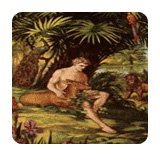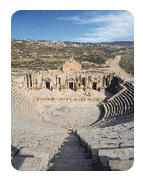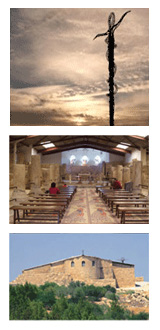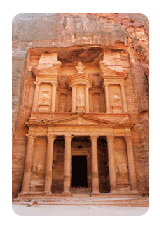|
Dead Sea
 For
Christians, this region inspires their faith.
This is the place where God first spoke to Man.
It is the Holy Land where God gave his Ten Commandments
to Moses, where Job suffered and was rewarded
for his faith, Where Jesus was baptized by John,
and where Jacob wrestled with the angel of God.
In the Book of Genesis, God refers to the Jordan
River Valley around the Dead Sea, as the "Garden
of the Lord", and it is believed to be the
location of the Garden of Eden,The infamous cities
of Sodom and Gomorrah and many other places were
the subjects of dramatic and enduring Old Testament
stories, including that of Lot, whose wife turned
into a pillar of salt for disobeying God's will. For
Christians, this region inspires their faith.
This is the place where God first spoke to Man.
It is the Holy Land where God gave his Ten Commandments
to Moses, where Job suffered and was rewarded
for his faith, Where Jesus was baptized by John,
and where Jacob wrestled with the angel of God.
In the Book of Genesis, God refers to the Jordan
River Valley around the Dead Sea, as the "Garden
of the Lord", and it is believed to be the
location of the Garden of Eden,The infamous cities
of Sodom and Gomorrah and many other places were
the subjects of dramatic and enduring Old Testament
stories, including that of Lot, whose wife turned
into a pillar of salt for disobeying God's will.
Twelve hundred years after the death of Moses,
the Bible claims that John the Baptist preached
and baptized in a place called Bethany Beyond
the Jordan. This place has now been identified
as Tell a-Kharrar and Elijah's Hill.
 Jerash Jerash
The history of Jerash is a blend of the Graeco-Roman
world of the Mediterranean basin and the ancient
traditions of the Arab Orient. Indeed, the name
of the city itself reflects this interaction.
The earliest Arabic / Semitic inhabitants named
their village Garshu. The Romans later Hellenized
the former Arabic name into Gerasa, and at the
end of the 19th century, the Arab and Circassian
inhabitants of the then small and rural settlements
transformed the Roman Gerasa into the Arabic Jerash.
It was not until the days of Alexander the Great
in the 4th century BC that Jerash truly began
to develop into a sizeable town. But it was during
the period of Roman rule, especially in the 2nd
Century A.D. that Jerash enjoyed its golden age.
 Madaba
(Mount Nebo) Madaba
(Mount Nebo)
According to the final chapter of Deutersonomy,
Mount Nebo is where the Hebrew prophet Moses was
given a view of the Promised Land that God was
giving to the Hebrews. "And Moses went up
from the plains of Moab to Mount Nebo, the top
of Pisgah, which is opposite Jericho.
(Deuteronomy 34:1). According to Jewish and Christian
tradition, Moses was buried on this mountain by
God himself, and his final resting place is unknown.
Scholars continue to dispute whether the mountain
currently known as Nebo is the same as the mountain
referred to in the Torah.
Islamic belief holds that Musa (Moses) was buried
not on the mountain but a few kilometers to the
west, somewhere beyond the River Jordan.
On the highest point of the mountain, Syagha,
the remains of a church and monastery have been
uncovered. The church, discovered in 1933, was
constructed in the second half of the 4th century
to commemorate the place of Moses' death. The
church design follows a typical basilica pattern.
It was enlarged in the late fifth century A.D.
and rebuilt in A.D. 597. The church is first mentioned
in an account of a pilgrimage made by a lady Aetheria
in A.D.
394. Six tombs have been found hollowed from the
natural rock beneath the mosaic-covered floor
of the church. In the present presbytery you can
see remnants of mosaic floors from different periods.
The earliest of these is a panel with a braided
cross presently placed on the east end of the
south wall.
 Petra Petra
During the time of Jesus and the Apostles, one
of the East Mediterranean's greatest trading centers
was located in the southern Jordan city of Petra,
the extensive rock-cut capital of the Nabataean
Kingdom. During the Exodus, Moses and the Israelites
passed through the Petra area in Edom. Local tradition
says that the spring at Wadi Musa (Valley of Moses),
just outside Petra, is the place where Moses struck
the rock and brought forth water (Numbers 20:10-11).
The Bible says that Moses was not allowed to enter
the Promised Land but could only glimpse it from
Mount Nebo because he struck the rock with his
rod to bring forth water, instead of speaking
to it, as God had commanded (Numbers 20:12-24).
Aaron, the brother of Moses and Miriam, who was
called by God to be Moses' prophet, died in Jordan
and was buried in Petra at Mount Hor, now called
Jabal Harun in Arabic (Mount Aaron). A Byzantine
church and later an Islamic shrine/tomb of Aaron
were built on the summit of the mountain, which
today attracts pilgrims from all over the world.
Aaron was the first High Priest of the Bible and
is remembered for the beautiful blessing that
God commanded him to give people: "The Lord
bless you and keep you; the Lord make his face
shine upon you, and be gracious to you; the Lord
lift up his countenance upon you and give you
peace" (Numbers 6:24-26).
Petra is sometimes called the 'Lost City'. In
spite of its being such an important city in antiquity,
after the 14th century AD, Petra was completely
lost to the western world. It was rediscovered
in 1812 by the Swiss traveler, Johann Ludwig Burckhardt,
who tricked his way into the fiercely guarded
site by pretending to be an Arab from India wishing
to make a sacrifice at the tomb of the Prophet
Aaron.
|



